Page 2 of 3
Posted: Tue Feb 16, 2010 9:28 pm
by bruno
While I am still puzzled by the mapimiensis, I wanted to share a few pictures of intertextus that I took in the last days.
Typical intertextus is smooth, with appressed, interlacing pink-grey radial spines up to 1.5 cm long, the lower central being very short. In contrast dasyacanthus has diffused and longer spines, the lower central being as long as the others, up to 2.5 cm (-4).
So this plant is clearly intertextus
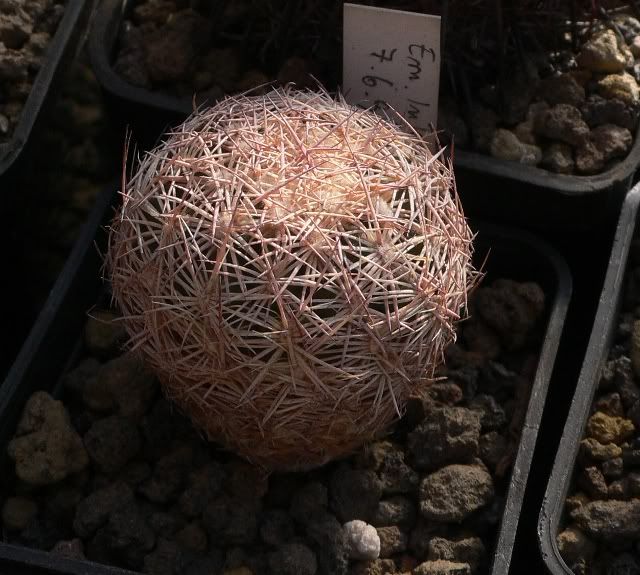
and this is dasyacanthus
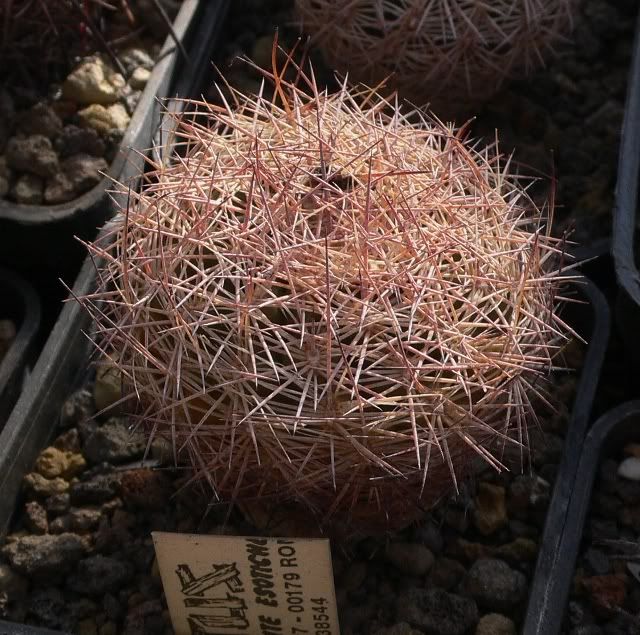
there are however intermediate forms, this is also dasyacanthus
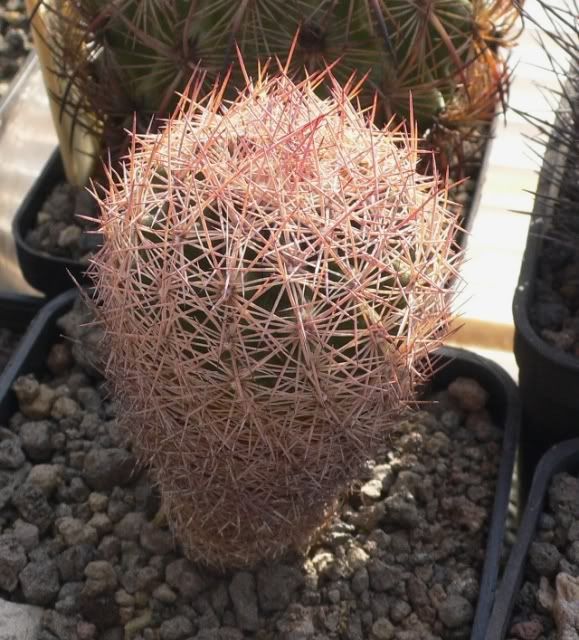
these seedlings are all 3 years old intertextus
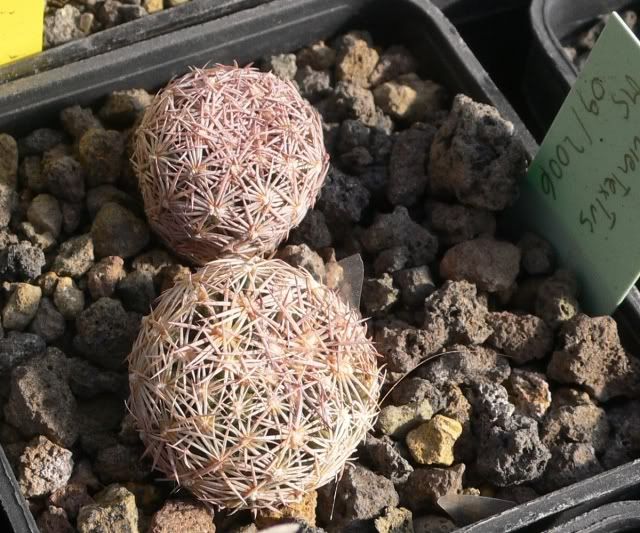
sb421
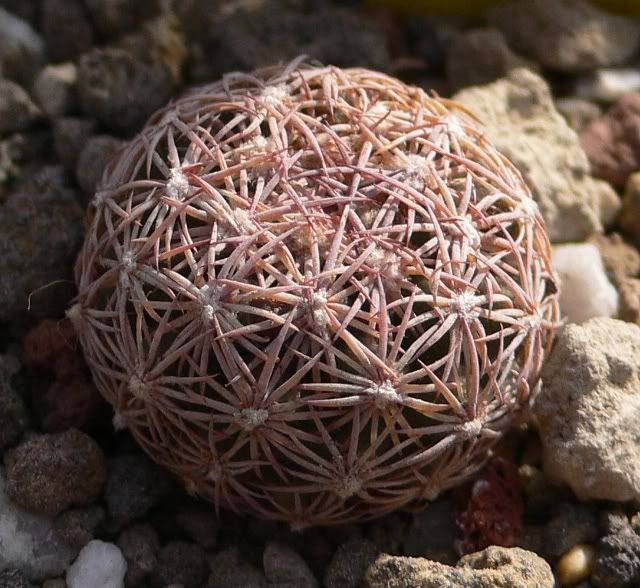
sb421 from the same seed batch with central spines!
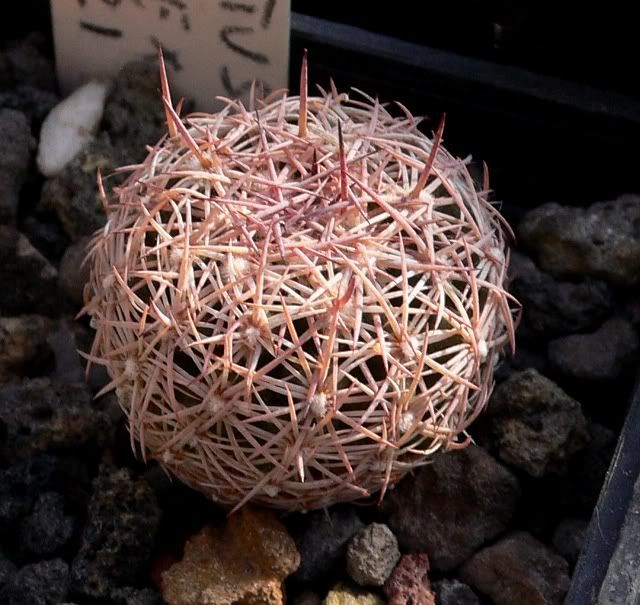
ciao
Posted: Tue Feb 16, 2010 9:31 pm
by Saguaro123
Beautiful spines.

Posted: Wed Feb 17, 2010 12:36 am
by peterb
Great looking plants, Bruno. I think Echinomastus intertextus and var. dasyacanthus are the easiest plants in the genus (from North America anyway). They are also among my favorites.
peterb
Posted: Thu Feb 18, 2010 3:19 am
by peterb
The Chihuahuan Echinomastus seem very closely related to each other indeed, similar to the rather distinct Sonoran/Mojavean Echinomastus, which also seem closely related to each other, but perhaps more distant from the Chihuahuan forms. The exception here looks like E. intertextus and ssp. dasyacanthus. These seem to be a sort of bridge to E. erectocentrus. Their ranges almost overlap. Some erectocentrus look very much like intertextus, especially when young.
It seems a shame to me that the most recent treatment of the Chihuahuan plants puts durangensis and laui under unguispinus as the only valid name with no recognized ssp. I wonder if further field work and DNA research will support this massive combination or perhaps re-separate some of these names.
What was Echinomastus krausii? It's now a synonym of erectocentrus, but I wonder if it had anything distinguishing about it or not.
peterb
Posted: Sat Feb 20, 2010 11:13 pm
by bruno
Hi Peter, it is raining and raining here, as soon as it stops a bit I' ll take a few other pictures of Echinomastus spines. Hope I can count on you for documentig the northern species

Referring to recent dna studies, Zimmermann and Parfitt in FNA report that "...although morphologically cohesive, Echinomastus is inferred to be a paraphyletic group, with some species (i. e. E. johnsonii) more closely related to Sclerocactus". Which I agree, and your statement as erectocentrus being somewhat linked to intertextus is a very interesting point. According to what I see on my terrace the unguispinus complex looks quite separate from the rest, with perhaps warnockii linked somehow to durangensis (a few plants we grow look as intermediate between the two). While warnockii is also linked to intertextus (Raun reports of hybrid populations in Brewster CO) I see no links between E. mariposensis and any other taxa of the genus. Laui is to me within unguispinus, I would be inclined to treat it (and durangensis) as a variety but the rank it deserves is a matter for botanist, which I am lucky I am not

Posted: Sun Feb 21, 2010 12:04 am
by iann
That's an intriguing quote from Zimmerman, much repeated by other authorities. For some reason, in the full report he references the molecular data of Nyffeler 2002 which does not include Sclerocactus or Echinomastus and is mainly concerned with South American cacti. It does also refer to Porter et al 2000 which is a study of Sclerocactus and Toumeya that includes many species including from Echinomastus, and so far as I know is the only published paper including Echinomastus species.
Posted: Sun Feb 21, 2010 1:00 am
by peterb
Nyffeler's work is *not* a valid reference for work supporting separation of Echinomastus? Why does it keep getting cited? How bizarre and frustrating. There's a real murky stew of muddy information floating around about Echinomastus, that's for sure. The plants have a wicked sense of humor.
I can't get FNA to load at all today, guess they are having server trouble?
peterb
Posted: Sun Feb 21, 2010 1:09 am
by peterb
by the way, Ian, you don't happen to have a copy of this, do you?
Mosco & Zanovello: 1997
Neolloydia gautii Benson: a tangled taxonomic history and two new
combinations. Bradleya 15:81.
Maybe I could order that Bradleya from BCSS still.
peterb
Posted: Sun Feb 21, 2010 11:37 am
by iann
Nyffeler's work is *not* a valid reference for work supporting separation of Echinomastus?
I have Nyffeler's 2002 paper: American Journal of Botany 89(2): 312-326 Phylogenetic Relationships in the Cactus Family (Cactaceae) based on evidence from
TRNK/
MATK and
TRNL-
TRNF sequences. This gives a high level overview of the whole family, but is almost entirely concerned with South American species. I see only four North American species sampled, none of them Sclerocactus or close relatives. Possibly there is another Nyffeler 2002 paper but I can't find any trace of it. Mention of this paper in connection with Echinomastus and Sclerocactus all seem to be directly lifted from Zimmerman's description judging by the words.
I don't have many Bradleyas, although they're very impressive. This one one seems to still be available:
http://www.bcss.org.uk/brad15.html
Posted: Sun Feb 21, 2010 9:37 pm
by king_hedes
o wouldhate to walk thry a feild of echinomastus's bare footed
Posted: Sun Feb 21, 2010 9:48 pm
by bruno
I see what you say Ian, Anderson refers to Porter 1999 drawing same conclusions on affinity but separation from Sclerocatus, Echinomastus "...exibiting a distinctive deletion in the DNA sequence." Porter' s paper is "Sclerocactus and Pediocactus: a summary of the molecular evidence. Cactus consensus initiatives 7: 5-6." Do you perhaps have a copy or know how I can find one


Posted: Sun Feb 21, 2010 11:07 pm
by iann
Another weirdity! I can find no reference to an article with that title, in CCI or anywhere else. CCI and various similar titles from that group are not always indexed well by the main journal libraries, but you'd think I'd find something. The title that Anderson gives is also subtly wrong, it is actually called Cactaceae Consensus Initiatives.
Porter's own bibliography doesn't mention any such article, but I also can't find it under any other author. My own index of that CCI issue does not include that article, although I don't have the whole publication.
So I guess my answer is no, I don't know where you can find it

Posted: Mon Feb 22, 2010 12:35 am
by peterb
This is very odd indeed! I thnk I'll email Porter directly and ask him about it.
peterb
Posted: Mon Feb 22, 2010 2:09 pm
by peterb
For anyone interested, the entire text of Nyffeler's article _Phylogenetic relationships in the cactus family (Cactaceae) based on evidence from trnK/ matK and trnL-trnF sequences1_ from the American Journal of Botany is online, including cladograms.
http://www.amjbot.org/cgi/content/full/89/2/312#F2
Ian's right, of course. There's precisely zero mention of Sclerocactus/Echinomastus in it, at least that I can see. How bizarre. We tend to take for granted that well respected scientists get their citations right. A good reminder to double check primary sources.
No response from Porter yet on the 1999 article.
peterb
Posted: Mon Feb 22, 2010 7:24 pm
by peterb
I did find this Porter, Kinney and Heil article from Haseltonia, from 2000:
http://www.rsabg.org/research/Porter/pd ... al2000.pdf
Interesting preliminary data seeming to show that Sclerocactus is monophyletic with Toumeya included but is fragmented into utter chaos without Toumeya. Sadly, only two Echinomastus species were included, johnsonii and erectocentrus. These do seem very closely related to Sclerocactus, if indeed Sclerocactus is even a valid genus.
peterb











